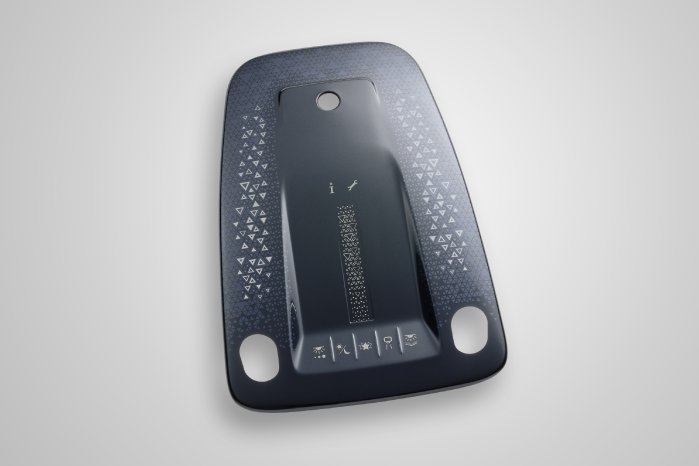Extensive functions with unlimited design freedom
The seamlessly enclosed Overhead Light Console (OHLC) features In-Mold electronics to control a wide range of functions. The integrated touch control in the Shy Tech and day-night designs allows operation of the sliding roof or reading lights, for example. The highly transparent and therefore invisible PolyTC® sensors are used in the visible area of the LED light surfaces. The organic three-dimensional deformation of the component surface highlights the intuitive operation of the touch sliders and buttons.
From backlighting and depth effects to different color variants and decors, to customer-specific durability requirements, all conceivable variants can be realized. There are no limits to design creativity: A black high-gloss look is just as possible as super matte or even soft-touch surfaces. Depending on the customer’s requirements, graphic or natural decors, for example in a wood look, can also be used. What’s more, integrated gobo projectors can be used to project logo or branding elements onto the center console.
New principle optimizes sensor integration
The series-ready and particularly efficient In-Mold Decoration process (IMD), which is realized using a single image in the classic roll-to-roll process, combines injection molding, sensor integration using functional In-Mold Labeling, and decoration in one highly efficient work step. During component production, trade show visitors can see the KURZ and POLY IC patented innovation for themselves in a live stream at the Wittmann Battenfeld booth. The 3D-deformed sensors are integrated according to the new ‘tail-from-center’ principle. A sliding device brings the sensor tail at a 45-degree angle to the component, ensuring perfect edge decoration beyond the tool edge. In addition, the sensor tail boasts a non-stick coating, which makes it easy to connect it to the back.
Efficiency goes hand in hand with sustainability
Compared to competing processes - such as varnishing or physical vapor deposition (PVD) - In-Mold Decoration is not only significantly more economical but also more sustainable. By combining different work steps into a one-shot process, CO2 emissions can be noticeably reduced. As the decorative layers are transferred to the component as a dry-transfer system, wet-paint contamination and post-drying energy are a thing of the past. Neither the wafer-thin touch sensors, which replace all the switches and buttons previously required, nor the decorative layers influence the recyclability of the component. Further improvements in the life cycle assessment and a saving of resources can also be achieved if recycled materials are used in injection molding. Depending on the customer’s requirements, these can either be visually emphasized by a corresponding finishing or laminated under a wafer-thin lacquer layer.
Online presence leading up to Fakuma
LEONHARD KURZ is also using its trade fair presence in Friedrichshafen to kick off a comprehensive online presentation of the company’s innovations and exhibition highlights. Visit fakuma.kurz.de for detailed information and extras such as videos or 3D animations on Fakuma products and topics.
At a glance
Fakuma 2021 - October 12-16, 2021
LEONHARD KURZ Stiftung & Co. KG: Hall A4, Stand A4-4122
Product group: Machines and equipment for finishing, decorating, printing, and marking
Trade fair presentation focuses on: Automotive interior/exterior, consumer electronics, home appliances, sustainability


